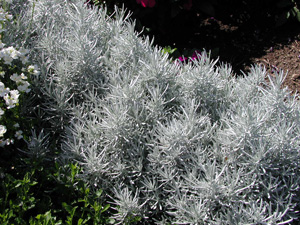Resource Library
Plant of the Week: Silver Spike
The University of Arkansas System Division of Agriculture does not promote, support or recommend plants featured in "Plant of the Week." Please consult your local Extension office for plants suitable for your region.
Plant of the Week
Silver spike
Latin: Helichrysum thianschanicum

I’ve always had the wanderlust but much of this desire was satiated by reading about the travels of others. One of the reasons I enjoy gardening is growing plants from far off lands and absorbing vicariously the feel of the place. Silver spike or Icicle plant (Helichrysum thianschanicum) is one such plant that hails from a mountain range I’ve always wanted to visit.
Silver spike is a perennial subshrub belonging to the daisy family that grows 2 feet tall and wide. In its native range on gravelly slopes and in the sand dunes of western China and adjacent Kazakhstan, it develops a finger-sized rhizome, a characteristic seldom seen in cultivation. It has the general shape and form of a lavender plant with basal branching and erect growing stems covered in 2-inch long linear leaves that are covered in white pubescence.
The yellow clusters of flowers are produced at the ends of stems over an extended period during the summer. Up to 30 yellow petal-less heads to about a third of an inch across are produced in the cluster and, while not spectacularly beautiful, do nicely punctuate the gray-white foliage during the summer.
Silver spike belongs to the overly large genus Helichrysum that contains as many as 600 species from the Old World (and Australia) that is in the process of being broken up into smaller, more cohesive genera. The genus is described as the “everlasting” plants because several of its species serve well as dried cut flowers if harvested before the blooms fully open, but silver spike is not grown for its flowers but its fine foliage effect.
The species epitaph, using an old spelling for a place name, tells us that this plant comes from the Tian Shan Mountains of Central Asia. Ever since I first read of Frank Meyer’s plant hunting exploits in the Tian Shan range that startles the border between China’s western most province of Xinjiang and Kazakhstan, I’ve wanted to visit that far-off region. Though I’ll likely never visit that lonely and isolated range, I can grow a plant that prospers on its rocky shoulders in hot dry locations up to 9,000 feet. The region is not just hot and dry, but come winter it is cold, often with temperatures dropping to minus 40 degrees Fahrenheit.
Though silver spike was described in 1879 by Eduard August von Regal (1815 – 1892), a German botanist who served as the director of the Russian Imperial Botanical Garden in St. Petersburg, it seems to have been little used in gardens until the 1990s when it was rediscovered during the new plant craze. ‘Icicle’, a selection grown by the Proven Winner group of plant propagators, has become the standard in the United States.
Though silver spike hails from a mountain range with hot dry summers and cold dry winters it is mostly grown as an annual plant in gardens. When hardiness listings are given, it is usually considered hardy in zones 9 and south. Like many plants from high desert regions it seems to be susceptible to the scourge of “winter wet,” a condition that results when the still active base of the plant freezes.
Silver spike makes an attractive addition to the annual or perennial border or it can be used as an addition to container plantings. Its flowers should pinched off as soon as they begin to fade to best display the silvery foliage. It seems resistant to most insect problems.
By: Gerald Klingaman, retired
Retired Extension Horticulturist - Ornamentals
Extension News - August 17, 2012
The University of Arkansas System Division of Agriculture does not maintain lists of retail outlets where these plants can be purchased. Please check your local nursery or other retail outlets to ask about the availability of these plants for your growing area.